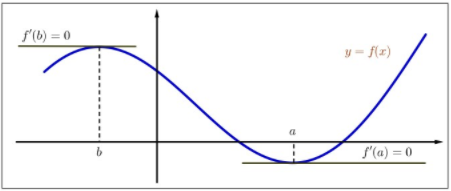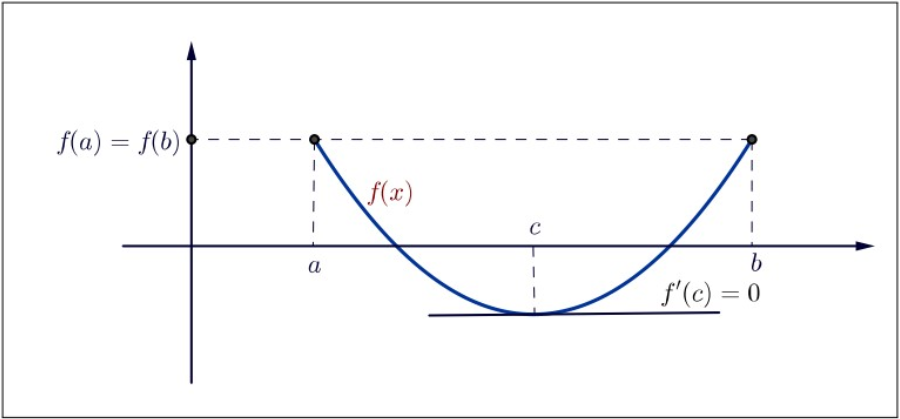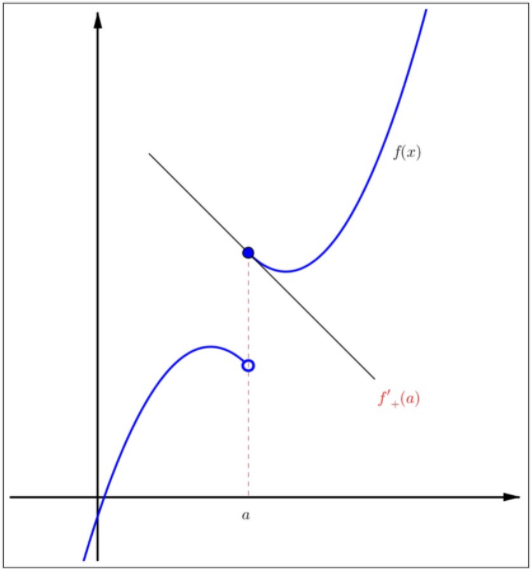4.2: THE MEAN VALUE THEOREM
( \newcommand{\kernel}{\mathrm{null}\,}\)
In this section, we focus on the Mean Value Theorem, one of the most important tools of calculus and one of the most beautiful results of mathematical analysis. The Mean Value Theorem we study in this section was stated by the French mathematician Augustin Louis Cauchy (1789-1857), which follows form a simpler version called Rolle's Theorem.
An important application of differentiation is solving optimization problems. A simple method for identifying local extrema of a function was found by the French mathematician Pierre de Fermat (1601-1665). Fermat's method can also be used to prove Rolle's Theorem.
We start with some basic definitions of minima and maxima. Recall that for a∈R and δ>0, the sets B(a;δ), B+(a;δ), and B−(a;δ) denote the intervals (a−δ,a+δ), (a,a+δ) and (a−δ,a), respectively.
Let D be a nonempty subset of R and let f:D→R. We say that f has a local (or relative) minimum at a∈D if there exists δ>0 such that
f(x)≥f(a) for all x∈B(a;δ)∩D.
Similarly, we say that f has a local (or relative) maximum at a∈D if there exists δ>0 such that
f(x)≤f(a) for all x∈B(a;δ)∩D.
In January 1638, Pierre de Fermat described his method for finding maxima and minima in a letter written to Marin Mersenne (1588-1648) who was considered as "the center of the world of science and mathematics during the first half of the 1600s." His method presented in the theorem below is now known as Fermat's Rule.
Let I be an open interval and f:I→R. If f has a local minimum or maximum at a∈I and f is differentiable at a, then f′(a)=0.

Figure 4.1: Illustration of Fermat's Rule.
- Proof
-
Suppose f has a local minimum at a. Then there exists δ>0 sufficiently small such that
f(x)≥f(a) for all x∈B(a;δ).
Since B+(a;δ) is a subset of B(a;δ), we have
f(x)−f(a)x−a≥0 for all x∈B+(a;δ).
Taking into account the differentiability of f at a yields
f′(a)=limx→af(x)−f(a)x−a=limx→a+f(x)−f(a)x−a≥0.
Similarly,
f(x)−f(a)x−a≤0 for all x∈B−(a;δ).
It follows that
f′(a)=limx→af(x)−f(a)x−a=limx→a−f(x)−f(a)x−a≤0.
Therefore, f′(a)=0. The proof is similar for the case where f has a local maximum at a. ◻
Let a,b∈R with a<b and f:[a,b]→R. Suppose f is continuous on [a,b] and differentiable on (a,b) with f(a)=f(b). Then there exists c∈(a,b) such that
f′(c)=0.
- Proof
-
Since f is continuous on the compact [a,b], by the extreme value theorem (Theorem 3.4.2) there exists ˉx1∈[a,b] and ˉx2∈[a,b] such that
f(ˉx1)=min{f(x):x∈[a,b]} and f(ˉx2)=max{f(x):x∈[a,b]}.
Then
f(ˉx1)≤f(x)≤f(ˉx2) for all x∈[a,b].

Figure 4.2: Illustration of Rolle's Theorem.
If ˉx1∈(a,b) or ˉx2∈(a,b), then f has a local minimum at ˉx1 or f has a local maximum at ˉx2. By Theorem 4.2.1, f′(ˉx1)=0 or f′(ˉx2)=0, and (4.3) holds with c=ˉx1 or c=ˉx2.
If both ˉx1 and ˉx2 are the endpoints of [a,b], then f(ˉx1)=f(ˉx2) because f(a)=f(b). By (4.4), f is a constant function, so f′(c)=0 for any c∈(a,b). ◻
We are now ready to use Rolle's Theorem to prove the Mean Value Theorem presented below.

Figure 4.3: Illustration of the Mean Value Theorem.
Let a,b∈R with a<b and f:[a,b]→R. Suppose f is continuous on [a,b] and differentiable on (a,b). Then there exists c∈(a,b) such that
f′(c)=f(b)−f(a)b−a.
- Proof
-
The linear function whose graph goes through (a,f(a)) and (b,f(b)) is
g(x)=f(b)−f(a)b−a(x−a)+f(a).
Define
h(x)=f(x)−g(x)=f(x)−[f(b)−f(a)b−a(x−a)+f(a)] for x∈[a,b].
Then h(a)=h(b), and h satisfies the assumptions of Theorem 4.2.2. Thus, there exists c∈(a,b) such that h′(c)=0. Since
h′(x)=f′(x)−f(b)−f(a)b−a,
it follows that
f′(c)−f(b)−f(a)b−a=0.
Thus, (4.5) holds. ◻
We show that |sinx|≤|x| for all x∈R.
Solution
Let f(x)=sinx for all x∈R. Then f′(x)=cosx. Now, fix x∈R, x>0. By the Mean value Theorem applied to f on the interval [0,x], there exists c∈(0,x) such that
sinx−sin0x−0=cosc.
Therefore, |sinx||x|=|cosc|. Since |cosc|≤1 we conclude |sinx|≤|x| for all x>0. Next suppose x<0. Another application of the Mean Value Theorem shows there exists c∈(x,0) such that
sin0−sinx0−x=cosc.
Then, again, |sinx||x|=|cosc|≤1. It follows that |sinx|≤|x| for x<0. Since equality holds for x=0, we conclude that |sinx|≤|x| for all x∈R.
We show that √1+4x<(5+2x)/3 for all x>2.
Solution
Let f(x)=√1+4x for all x≥2. Then
f′(x)=42√1+4x=2√1+4x.
Now, fix x∈R such that x>2. We apply the Mean Value Theorem to f on the interval [2,x]. Then, since f(2)=3, there exists c∈(2,x) such that
√1+4x−3=f′(c)(x−2).
Since f′(2)=2/3 and f′(c)<f′(2) for c>2 we conclude that
√1+4x−3<23(x−2).
Rearranging terms provides the desired inequality.
A more general result which follows directly from the Mean Value Theorem is known as Cauchy's Theorem.
Let a,b∈R with a<b. Suppose f and g are continuous on [a,b] and differentiable on (a,b). Then there exists c∈(a,b) such that
[f(b)−f(a)]g′(c)=[g(b)−g(a)]f′(c).
- Proof
-
Define
h(x)=[f(b)−f(a)]g(x)−[g(b)−g(a)]f(x) for x∈[a,b].
Then h(a)=f(b)g(a)−f(a)g(b)=h(b), and h satisfies the assumptions of Theorem 4.2.2. Thus, there exists c∈(a,b) such that h′(c)=0. Since
h′(x)=[f(b)−f(a)]g′(x)−[g(b)−g(a)]f′(x),
this implies (4.6). ◻
The following theorem shows that the derivative of a differentiable function on [a,b] satisfies the intermediate value property although the derivative function is not assumed to be continuous. To give the theorem in its greatest generality, we introduce a couple of definitions.
Let a,b∈R, a<b, and f:[a,b]→R. If the limit
limx→a+f(x)−f(a)x−a
exists, we say that f has a right derivative at a and write
f′+(a)=limx→a+f(x)−f(a)x−a.
If the limit
limx→b−f(x)−f(b)x−b
exists, we say that f has a left derivative at b and write
f′−(b)=limx→b−f(x)−f(b)x−b.
We will say that f is differentiable on [a,b] if f′(x) exists for each x∈(a,b) and, in addition, both f′+(a) and f′−(b) exist.
Let a,b∈R with a<b. Suppose f is differentiable on [a,b] and
f′+(a)<λ<f′−(b).
Then there exists c∈(a,b) such that
f′(c)=λ.

Figure 4.4: Right derivative.
- Proof
-
Define the function g:[a,b]→R by
g(x)=f(x)−λx.
Then g is differentiable on [a,b] and
g′+(a)<0<g′−(b).
Thus,
limx→a+g(x)−g(a)x−a<0.
It follows that there exists δ1>0 such that
g(x)<g(a) for all x∈(a,a+δ1)∩[a,b].
SImilarly, there exists δ2>0 such that
g(x)<g(b) for all x∈(b−δ2,b)∩[a,b].
Since g is continuous on [a,b], it attains its minimum at a point c∈[a,b]. From the observations above, it follows that c∈(a,b). This implies g′(c)=0 or, equivalently, that f′(c)=λ. square
The same conclusion follows if f′+(a)>λ>f′−(b).
Exercise 4.2.1
Let f and g be differentiable at x0. Suppose and
f(x)≤g(x) for all x∈R.
Prove that f′(x0)=g′(x0).
- Answer
-
Add texts here. Do not delete this text first.
Exercise 4.2.2
Prove the following inequalities using the Mean Value Theorem.
- √1+x<1+12x for x>0.
- ex>1+x, for x>0. (Assume known that the derivative of ex is itself.)
- x−1x<lnx<x−1, for x>1. (Assume known that the derivative of lnx is 1/x.)
- Answer
-
Add texts here. Do not delete this text first.
Exercise 4.2.3
Prove that |sin(x)−sin(y)|≤|x−y| for all x,y∈R.
- Answer
-
Add texts here. Do not delete this text first.
Exercise 4.2.4
Let n be a positive integer and let ak,bk∈R for k=1,…,n. Prove that the equation
x+n∑k=1(aksinkx+bkcoskx)=0
has a solution on (−π,π).
- Answer
-
Add texts here. Do not delete this text first.
Exercise 4.2.5
Let f and g be differentiable functions on [a,b]. Suppose g(x)≠0 and g′(x)≠0 for all x∈[a,b]. Prove that there exists c∈(a,b) such that
1g(b)−g(a)∣f(a)f(b)g(a)g(b)∣=1g′(c)∣f(c)g(c)f′(c)g′(c)∣,
where the bars denote determinants of the two-by-two matrices.
- Answer
-
Add texts here. Do not delete this text first.
Exercise 4.2.6
Let n be a fixed positive integer.
- Suppose a1,a2,…,an satisfy
a1+a22+⋯+ann=0.
Prove that the equation
a1+a2x+a3x2+⋯+anxn−1=0
has a solution in (0,1).
- Suppose a0,a1,…,an satisfy
n∑k=0ak2k+1=0.
Prove that the equation
n∑k=0akcos(2k+1)x=0
has a solution on (0,π2).
- Answer
-
Add texts here. Do not delete this text first.
Exercise 4.2.7
Let f:[0,∞)→R be a differentiable function. Prove that if both limx→∞f(x) and limx→∞f′(x) exist, then limx→∞f′(x)=0
- Answer
-
Add texts here. Do not delete this text first.
Exercise 4.2.8
Let f:[0,∞)→R be a differentiable function.
- Show that if limx→∞f′(x)=a, then limx→∞f(x)x=a.
- Show that if limx→∞f′(x)=∞, then limx→∞f(x)x=∞.
- Are the converses in part (a) and part (b) true?
- Answer
-
Add texts here. Do not delete this text first.


